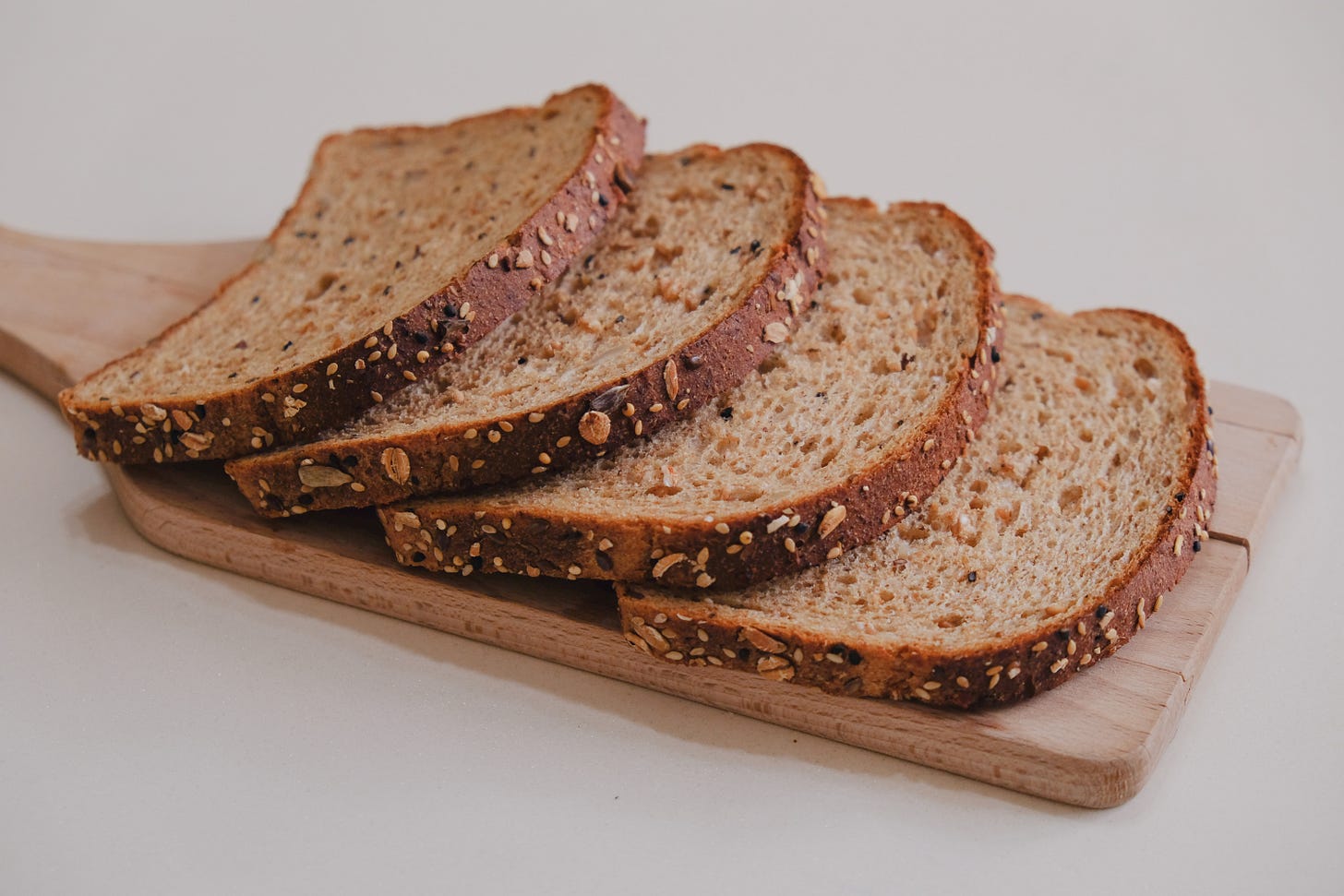Welcome to Thursday Things! If you enjoy this edition, please click the heart icon in the header or at the end of the post to let me know. You can post a comment by clicking the dialog bubble.
Thanks, Otto! Photo by Young Shih on Unsplash
Slice, slice, baby. Do you know the name Otto Frederick Rohwedder? Probably not. But you’ve definitely enjoyed Mr. Rohwedder’s greatest invention: sliced bread.
When Was Sliced Bread Invented?
Today’s consumers would have difficulty imagining a world without sliced bread, but it’s actually a somewhat new concept. While bread has been around for thousands of years, sliced bread is less than a century old — people are alive today who are older than sliced bread. What bakers thought would be a passing fad has become a staple in kitchens across the world.
The way we commonly eat bread now is not how most of humanity did it for most of history.
An early loaf of bread would look foreign to the modern consumer — it took on various shapes rather than even loaves and contained whichever ingredients were on hand. To eat it, you’d tear off a piece, hence the expression “break bread together.” People continued to tear or slice loaves of bread in their own kitchens until the 20th century.
But Otto Rohwedder had a vision and the dream of a better way. He quit his job and put all his savings into inventing a bread slicing machine. Because America.
There were many setbacks on his quest, including a fire that destroyed all his blueprints and his prototype. But Otto persisted. Because he knew that we, the people of the future, would not have time to slice our own bread.
Finally, in 1928, he succeeded. And it was on this date 94 years ago — July 7, 1928 — that sliced bread was first advertised to the public.
In 1928, the Chillicothe Constitution-Tribune, where the Chillicothe Baking Company was located, published an advertisement with the headline, “Sliced Bread Is Made Here.” The advertisement references a “power-driven multi-bladed bread slicer” capable of performing an impossible feat — slicing whole loaves of bread at once.
This was the first-ever reference to sliced bread in print. It offered instructions for the consumer, suggesting you should “open [the] wrapper at one end” and “pull out the pin” to access a slice of bread. It also called sliced bread “the greatest forward step in the baking industry since bread was wrapped.” Before long, major baking companies joined the trend of making sliced bread. Within a few years, bakeries were producing more sliced loaves than unsliced loaves.
Today, we take sliced bread for granted, but it truly revolutionized kitchens across America and the world. Otto Rohwedder’s bread-slicing machine saved housewives (because that’s who was doing most of the bread-prepping, toasting, and sandwich-making back then. And maybe now too. YMMV.) countless hours of kitchen labor.
Uniform bread slices made it much easier to make a few sandwiches for your children’s lunches or pieces of toast for breakfast. As a result, people began eating more bread.
Eating more bread may or may not be a good thing. Regardless, sliced bread opened the way for mass market brands like Wonder Bread, gave the toaster industry a boost, and transformed how we eat.
The advent of slice bread had such a huge impact that it became a byword for innovation and gave us a popular expression you’ve probably used to show your appreciation of someone or your enthusiasm for a positive development: “It’s the greatest thing since sliced bread!”
Click through the the article for more about the remarkable life of Otto Rohwedder, his invention’s impact, the outcry against the ill-considered wartime Sliced Bread Ban of 1943 and more.
Rohwedder’s bread-slicing machine in the National Museum of American History
And maybe pop a couple of slices in the toaster and say a word of thanks to old Otto!
How to not be spied on. I have never stayed in an Airbnb rental and don’t have any immediate plans to. But for those who do, hidden cameras are apparently a real concern. Kim Komando has a few tip on How to spot hidden surveillance cameras in your Airbnb, VRBO, or vacation rentals
Larger cameras are easy to spot, but anyone can easily hide smaller cameras behind furniture, vents, or decorations. A simple way to spot most types of cameras is to look for the lens reflection.
• Turn off the lights and slowly scan the room with a flashlight or laser pointer, looking for bright reflections.
• Scan the room from multiple spots so you don't miss a camera pointed only at certain places.
• Inspect the vents and any holes or gaps in the walls or ceilings.
You can also get an RF detector. This gadget can pick up wireless cameras you might not see. Unfortunately, RF detectors aren’t great for wired or record-only cameras. For those, you’ll need to stick with the lens reflection method.
Read the whole thing for more advice on looking for secret cameras — and what to do if you find one at your rental.
Forget it, Jake. It’s Florida. Honestly, I could fill this entire newsletter every week with nothing but items from Florida. But that would be the easy way out! Still, it’s good to check on our friends in the Sunshine State from time to time to see how they’re doing.
Giant Concrete-Eating Snails Trigger Florida Quarantine
Sounds about right.
Thank you for reading Thursday Things! Again, please click the hearts, leave a comment, and use the share feature to send this issue to a friend who might enjoy it. See you next Thursday!



